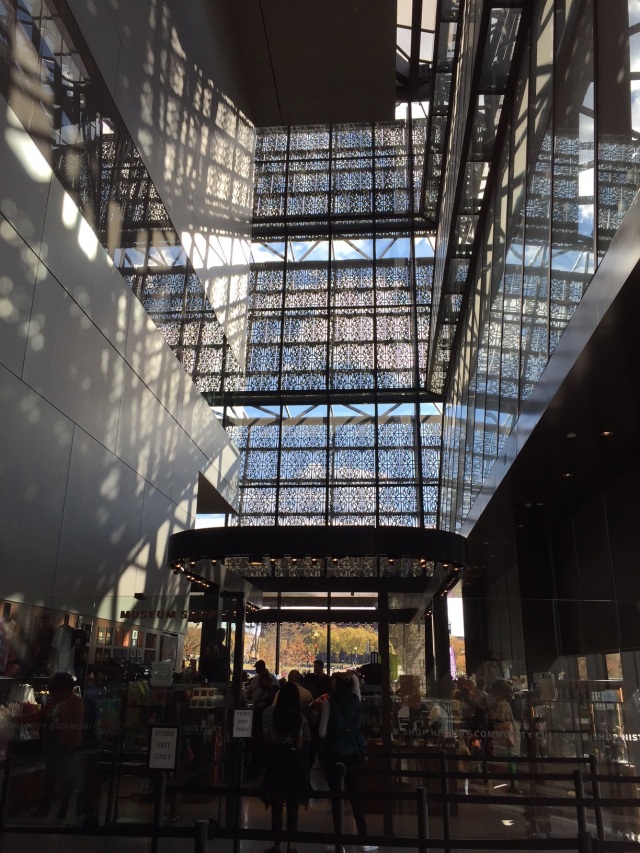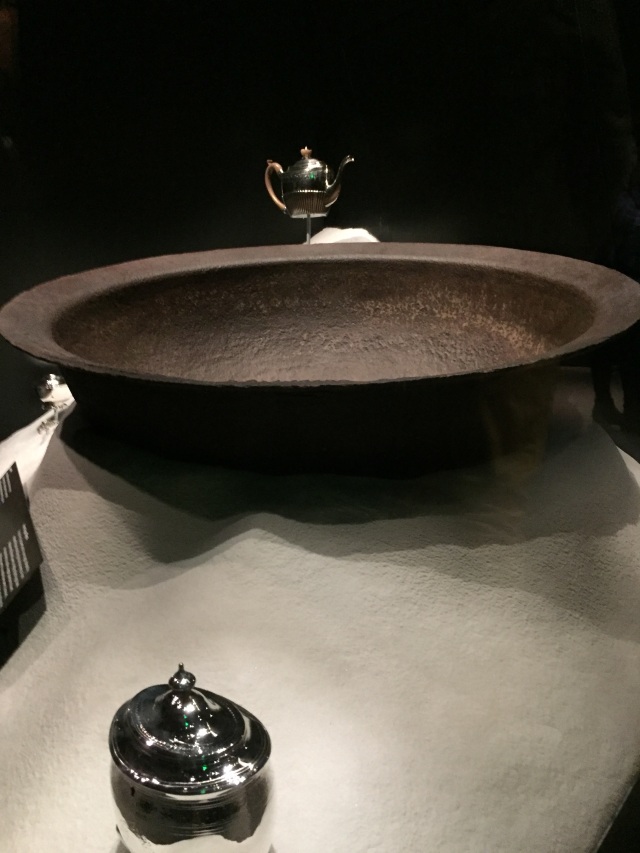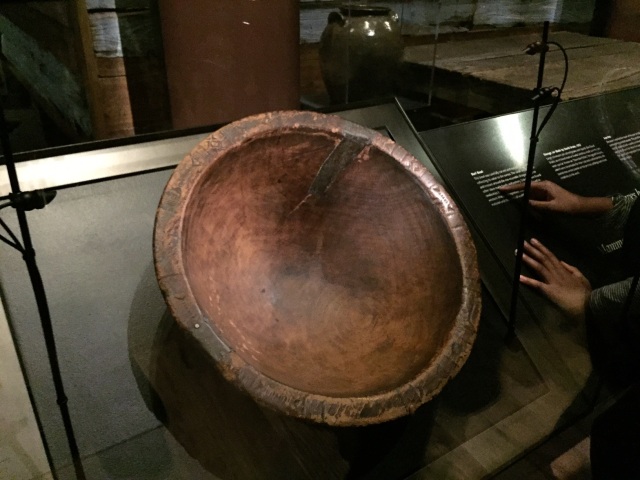A guest post by Laura Macaluso
The Smithsonian Institution’s newest museum—and the last projected to be built directly on the National Mall in Washington, D.C.— the National Museum of African American History & Culture (NMAAHC), opened to great fanfare on September 24, 2016. Crowds appeared on that day and haven’t ceased; except for a handful of timed tickets given out every morning, the museum is sold out through the spring of 2017. The building, clad in a multi-tiered framework of intricate geometric patterns burnished with a bronze colored coating (the framework is actually aluminum, for lightness and durability), is juxtaposed against the whiteness of the Washington Monument nearby. Thus, the first monument built on the Mall (1848-1888) and this latest addition to the American story—elevating and celebrating African American people through the shared experience of visiting monuments and museums—continue to demonstrate how great places contribute significantly to the practice of public history and the preservation of culture.

Interior of the National Museum of African American History and Culture, Smithsonian Institution. Photograph by author.
That some of this public history and preservation work is done through the study and appreciation of foodways (the word scholars use to talk about the study of everything food) is no surprise: food is front and center in historic sites and museums today because the subject is a point of access for visitors of all ages, ethnicities, and economics: everyone eats. The “intersection of food in culture, traditions, and history” is both deep and broad. I’m not ashamed to admit I went to the NMAAHC with the intention of visiting Sweet Home Café, the museum’s in-house cafeteria whose purpose is to “tell the story of African-American contributions through the food they made and ate,” according to supervising chef Albert Lukas. I am a huge fan of the National Museum of the American Indian’s Mitsitam Café, which offers “traditionally prepared dishes along with conventional items infused with Native ingredients.” The NMAI has focused on food in its interpretive programming since opening twelve years ago, and its award-winning restaurant furthers the mission. The NMAAHC clearly wanted to follow their success—but, it turns out that right now, the success of the museum means the café is not big enough to hold the crowds. Fortunately, the two cross streets around the museum were filled with food trucks, providing an international selection of lunch options (no doubt graduate students are already writing papers on the foodways of the food truck movement).
Back inside the museum, my focus on food found another way in: through objects on display in the history galleries. Although there are amazing objects to view in the galleries, such as Nat Turner’s bible and the silk lace shawl given to Harriet Tubman by Queen Victoria, the two objects that caught my attention are part of the story of food and how it intersects with African America life—how food was grown, processed, and consumed, and who was involved with each of these steps. These objects reminded me that even in the twenty-first century, questioning where and how food is produced is a question not only for foodways scholars, but, for everyone.

Display of iron sugar pot, Collection of the National Museum of African American History and Culture, Smithsonian Institution. Photograph by author.

Burl bowl with incised patterns, Collection of the National Museum of African American History and Culture, Smithsonian Institution. Photograph by author.
The first object, a giant cast iron “sugar pot” was used to boil down cane sugar on plantations in the lower Americas and the Caribbean. The display of this huge object, placed in a double-sided glass case on the corner where two walls meet, is arresting, with the pitted rimmed pot sitting on top of a mound of pure white sugar. Placed next to the pot are refined silver objects: a tea pot, sugar bowl and tongs. I don’t need to spell out the analogies here.
Further along in the galleries I was drawn to another large object, this time a hand carved wooden bowl. Like the iron sugar pot, this bowl was worn, with two major areas of loss which the bowl’s owner had fixed with nails and a filler. The rim of the wooden bowl is decorated with geometric designs—a powerful statement of humanity, which stands in contrast to the iron sugar pot, which is strictly utilitarian and surely a despised object. The sugar pot—a object that represented the worst of plantation life in the Americas, where enslaved men lived on average only seven years before dying from the harsh work—stands in contrast to the wooden bowl, which is soft and suggests warmth and nourishment.
Although the two objects are not displayed in the same gallery, they are both part of the study of food, history and cultural preservation. The museum states that “creative cooking helped nourish enslaved families in body and soul.” Cultural memories were preserved in the engraved patterns, as was the food served in the bowl. This may be one of the reasons foodways has such a large interest in the twenty-first century—perhaps there are things missing from society and we humans are looking for both nourishment and for ways to preserve our memories and histories in a fast changing society.
The curators of the new museum had to create from the foundation up a new collection through which they could share African American history and culture. These two objects—an old iron pot and an old wood bowl—both seemingly without much monetary value or design interest , both hold fabulous stories within their rims.
Laura A. Macaluso, Ph.D. holds degrees in art history and the humanities from Southern Connecticut State University, Syracuse University in Italy and Salve Regina University. She has worked as a grants writer and curator in historic sites, museums, art, and park organizations. She held a Fulbright at the Swaziland National Museum in 2008-2009, and returned in 2010 under an Ambassador’s Fund for Cultural Preservation award from the State Department. She curated the exhibit “An Artist at War: Deane Keller, New Haven’s Monuments Man” and authored the accompanying article in Connecticut Explored magazine (Winter 2014-2015). Her newest book, New Haven in World War I (forthcoming from The History Press, 2017) was endorsed by the World War One Centennial Commission.
